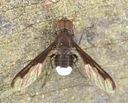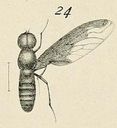Anthrax
Anthrax
Classification
- Phylum: Arthropoda
- Subphylum: Hexapoda
- Class: Insecta
- Order: Diptera
- Superfamily: Asiloidea
- Family: Bombyliidae
- Subfamily: Anthracinae
- Tribe: Anthracini
- Genus: Anthrax
Pronunciation
How to pronounce Anthrax: //ˈænθræks//
These audio files are automatically generated. While they are not always 100% accurate, they are a good starting point.
Images






Summary
Anthrax is a genus of flies belonging to the family Bombyliidae, noted for their parasitic larvae that feed primarily on solitary bees and wasps. Members of this genus are important for their ecological role in various ecosystems and can serve as indicators of environmental health due to their specialized life cycles.
Physical Characteristics
Small, typically 6–7 mm long; many species with distinctive patterns and coloration.
Identification Tips
Look for hovering flight behavior and the ability to flip eggs into the nests of solitary bees and wasps.
Habitat
Variety of habitats including grasslands, meadows, and areas near nesting sites of solitary bees and wasps.
Distribution
Most diverse in Eurasia and Africa; 38 species reported in local area, with 11 species in the eastern regions and the rest in western regions.
Diet
Larvae feed on the larvae of solitary bees and wasps, with some reported cases of parasitizing tiger beetles and megachilid bees.
Life Cycle
Females hover and lay eggs near the nests of solitary bees and wasps; larvae hatch and consume the stored food in the cells.
Reproduction
Sexual reproduction with females laying eggs in the burrows of their hosts.
Predators
Various insectivorous birds and other insect predators may feed on adults or larvae.
Ecosystem Role
As parasitoids, they may help control solitary bee and wasp populations and play a role in pollination as adults.
Collecting Methods
- Netting individuals during the adult flying period
- Using traps set near nesting sites of solitary bees and wasps
Preservation Methods
- Pinning
- Alcohol preservation in 70% ethanol
Misconceptions
Misunderstandings about their association with the bacterium causing anthrax in humans; the genus Anthrax does not directly cause the disease anthrax.
Tags
- Entomology
- Diptera
- Parasitism
- Biodiversity